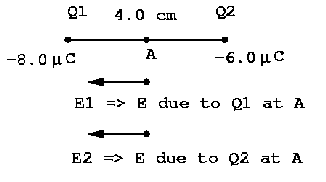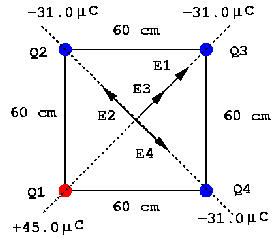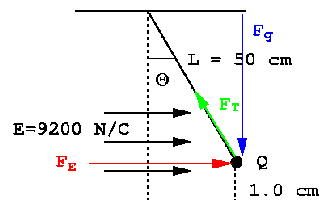
Q18)Consider the electric field at the three points indicated by the letters A, B, and C in Fig. 16-36 (of your text). First draw an arrow at each point indicating the direction of the net force that a positive test charge would experience if placed at that point, then list the letters in order of decreasing field strength (strongest first).
SOLUTION: Pictoral representation - on reserve in S and E library
For a positive charge, the force is in the same direction as the field. As
far as strength goes, the closer the field lines, the stronger the field.
Looking at how close the lines are at A, B, and C indicates that the field
is strongest at A and weakest at C. In fact, the field is zero at C
(imagine that you're a positive charge placed between these two charges -
what net force acts on you?).
P22)What is the magnitude and direction of the electric force on an electron in a uniform electric field of strength 3500 N/C that points due east?
SOLUTION:
Since the E electric field points east, the force on an electron would
point in the opposite direction, west. (The F force on a proton
would point in the same direction as theE field).
| F | = e | E | = (1.6 x 10 -19 C) (3500 N/C)
| F | = 5.6 x 10 -16 N
P26)What is the magnitude and direction of the electric field at a
point (A) midway between a -8.0 µC and a +6.0 µC charge 4.0 cm
apart?
SOLUTION:

P29)Determine the direction and magnitude of the electric field at the point P shown in Fig. 16-40 (of your text). The two charges are seperated by a distance of 2a and the point P is a distance of x out on the perpendicular bisector of the line joining them. Express your answers in terms of Q, x, a, and k.
SOLUTION:

P31)Calculate the electric field at the center of a square 60 cm on a
side if one corner is occupied by a +45.0 µC charge and the other
three are occupied by a -31.0 µC charges.
SOLUTION:

P34)Draw, approximately, the electric field lines about two point
charges, +Q and -3Q, which are a distance l
apart.
SOLUTION: Pictoral representation - on reserve in S and E library
Because the negative charge is three times larger than the positive
charge, three times as many field lines come in to the negative charge
as leave the positive charge.
P38)An electron (mass m = 9.1 x 10 -31kg is accelerated in the uniform field E (E = 1.85 x 10 4 N/C) between the two parallel charged plates. The seperation of the plates is 1.20 cm. The electron is accelerated from rest near the negative plate, (Fig. 16-44 of your text). (a) With what speed does it leave the hole? (b) Show that the gravitational force can be ignored.
SOLUTION:
(a)ma = F = e E so the acceleration a =
(1.6 x 10-19) (1.85 x 10 4) / (9.1 x 10 -31) (m/s2).
a = 3.25 x 10 15 m/s2
v = (a)(t), x = 1/2 a t2, so t = [(2)(x) /
(a)] 1/2 and v = [(2)(x)(a)]1/2
v = [2(0.012)(3.25 x 10 15]1/2
(m/s) = 8.83 x 106 m/s
(b)gravitational force magnitude = mg =
(9.1 x 10 -31 kg) (9.8 m/s2) = 8.9 x 10
-30 N
electric force magnitude = e E = 2.96 x 10
-15 N , so mg << e E and the effects due to
gravity are extremely
small.
P49)A point charge (m = 1.0 g) at the end of an insulating string of
length 50 cm (Fig. 16-46) is observed to be in equilibrium in a known
uniform horizontal electric field, E = 9200 N/C, when the pendulum has
swung so it is 1.0 cm high. If the field points to the right in
Fig. 16-46, determine the magnitude and sign of the point
charge.
SOLUTION:
